The best advice is the simplest: stay away from crowds. Use the “rule of thumb” for any disaster waiting to happen, by which I mean “If you can't cover it with your thumb held out at arm's reach, you're too close.” Avoiding problems is the easiest way to deal with them, so not being where the trouble occurs is the simplest way to deal with an unruly mob.
The worst thing you can do is to go looking for trouble. Unless you have serious back-up on many levels, from legal to firepower, you're not going to be able to do much good. The only time preemptive action will work is if we enter a truly WROL (Without Rule of Law) scenario and that is a “survive at any cost” situation.
Defense against an unruly mob or group of attackers is a roll of the dice.
- Locally, we had a bar owner shoot and kill a man who had already assaulted one person and was in the act of assaulting the bar owner. The local prosecutor looked at the evidence and decided to file no charges, but after a couple of days of “protests” he changed his mind and turned it over to a grand jury. The grand jury indicted the bar owner for murder.
- The lawyer couple in St, Louis that were armed while telling protesters to leave their property have been charged. That case is still ongoing.
- People who display a firearm against a crowd attacking their vehicle may get away unscathed, but there are groups ready to identify them and ruin their lives. Being fired from a job, having your personal information posted online, being defamed in public media and forums, and civil lawsuits are all tactics used by the organizers of some of these protests.
Some of you may have heard of Masad Ayoob. He's been teaching firearms use for decades internationally and is one of the world's experts on defensive firearms use. He did a rather long interview a few months back on this subject and covered it in detail. I strongly suggest you find the time to sit and watch or listen to his advice. At the very least, read through the shortened transcript.
The highlights are:
- Avoid crowds.
- If you run into a crowd, try to get away.
- If you can't get away, try to deescalate the situation.
- If your life is in danger, you do have the right to defend yourself against that threat, but only that threat.
- Know your target and what is beyond it. You're responsible for everything damaged by your bullets.
- Not everyone in a crowd is a legal target; most of them are not going to be violent.
- Handguns are easier to keep control of, are less likely to over-penetrate a target, and are easier to use in a vehicle than a long gun.
- Outside of WROL, you will be held responsible for your actions.
- Lawyers will be involved and they're expensive.
- Know your local laws and how they are enforced. Some areas are not friendly to self-defense.
- Being in a car adds to the problems; newer cars won't let you run over a person and airbags deploying will incapacitate you for minutes.
- Firing a weapon inside a car will damage your hearing permanently.
He did cover the “Rooftop Koreans” briefly, as well as a few other historical examples of people defending themselves against unruly mobs. The LA riots were a WROL situation since the police had been pulled back. There were about two dozen “unsolved” deaths, but no definite examples of defenders killing rioters. More recent events have been treated differently, depending entirely upon the political views of the courts and prosecutors involved.
Short of a total collapse of infrastructure I feel fairly safe in my area, but I know some of you are living in areas that are likely to see rioting if things don't calm down soon. Keep your eyes open, your training current, and your powder dry.



























